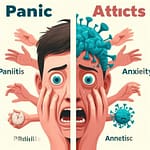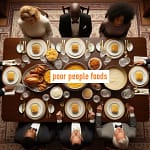People often use the terms “panic attack” and “anxiety attack” interchangeably, but they refer to distinct experiences with their unique characteristics. In this comprehensive guide, we’ll delve into the differences between panic attacks and anxiety attacks, exploring their symptoms, causes, risk factors, diagnosis, treatment options, home remedies, and more.
Panic Attack vs. Anxiety Attack: What Sets Them Apart
Panic attacks and anxiety attacks are not the same, despite the common misconception. Let’s explore the fundamental distinctions between these two emotional states:
Panic Attack:
- Sudden onset: Panic attacks come on unexpectedly and abruptly, often without an identifiable trigger.
- Intense fear: They involve overwhelming and intense fear, often accompanied by a feeling of impending doom.
- Physical symptoms: Panic attacks manifest with severe physical symptoms, such as rapid heartbeat, shortness of breath, and nausea.
- Fight-or-flight response: The body’s fight-or-flight response is triggered during a panic attack, leading to more pronounced physical symptoms.
- Potential mental and behavioral effects: Panic attacks can lead to avoidance behavior, as individuals may fear having another attack.
Anxiety Attack:
- Gradual build-up: Anxiety attacks tend to develop gradually in response to specific stressors, situations, or thoughts.
- Worry and distress: Anxiety attacks are characterized by excessive worry, distress, and fear, often related to a specific stressor.
- Less intense physical symptoms: While physical symptoms are present, they are generally less severe compared to panic attacks.
- Variable intensity: Anxiety attacks can range from mild to moderate to severe, depending on the individual’s response to stressors.
- Behavioral impact: They may not necessarily result in avoidance behavior, as anxiety attacks are often linked to specific stressors.
Symptoms of Panic Attacks and Anxiety Attacks
Both panic attacks and anxiety attacks share emotional and physical symptoms. It’s possible to experience a combination of these symptoms during an episode:
Emotional Symptoms:
- Apprehension and worry
- Distress and fear
- Fear of losing control or dying
- Sense of detachment from reality (derealization) or oneself (depersonalization)
Physical Symptoms:
- Rapid or accelerated heartbeat
- Chest pain
- Shortness of breath
- Throat tightness or feeling of choking
- Dry mouth
- Sweating
- Chills or hot flashes
- Trembling or shaking
- Numbness or tingling (paresthesia)
- Nausea, abdominal pain, or upset stomach
- Headache
- Dizziness or feeling faint
Distinguishing Factors Between Panic and Anxiety Attacks
While the symptoms can overlap, several factors help differentiate between panic and anxiety attacks:
- Cause: Anxiety attacks are typically a response to perceived stressors, while panic attacks can occur without an obvious cause.
- Level of Distress: Anxiety attacks can vary in intensity from mild to severe, while panic attacks often involve severe and disruptive symptoms.
- Fight-or-Flight Response: Panic attacks trigger the body’s fight-or-flight response, resulting in more intense physical symptoms compared to anxiety attacks.
- Speed of Onset: Anxiety may build gradually, whereas panic attacks come on suddenly and unexpectedly.
- Effect: Panic attacks often lead to concerns or fears of having another attack, potentially influencing behavior and choices.
Causes and Triggers
Both panic and anxiety attacks can be triggered by similar factors, including:
- Stressful jobs
- Social situations
- Phobias (e.g., agoraphobia, claustrophobia, acrophobia)
- Traumatic experiences or memories
- Chronic illnesses (e.g., heart disease, diabetes, irritable bowel syndrome)
- Chronic pain
- Withdrawal from substances (e.g., drugs, alcohol)
- Caffeine consumption
- Medications and supplements
- Thyroid problems
Risk Factors
Risk factors for experiencing panic and anxiety attacks include:
- Previous trauma or witnessing traumatic events
- Stressful life events (e.g., loss of a loved one, divorce)
- Ongoing stress and worries (e.g., work responsibilities, financial concerns)
- Living with a chronic health condition
- Having an anxious personality
- Coexisting mental health conditions (e.g., depression)
- Family history of anxiety or panic disorders
- Substance use (drugs or alcohol)
Diagnosis and Seeking Help
Diagnosing panic attacks and anxiety attacks primarily involves assessing symptoms and ruling out other conditions with similar symptoms, such as heart disease or thyroid problems. To reach a diagnosis, healthcare providers may perform:
- Physical examinations
- Blood tests
- Heart tests (e.g., electrocardiogram)
- Psychological evaluations or questionnaires
It’s crucial to seek professional help if you’re experiencing symptoms of panic or anxiety attacks that significantly affect your daily life.
Treatment Options
Treatment for panic and anxiety attacks can involve a combination of approaches tailored to individual needs. Here are common treatment options:
Counseling and Psychotherapy:
- Cognitive Behavioral Therapy (CBT)
- Cognitive Therapy
- Exposure Therapy
- Relaxation Techniques
Medications:
- Antidepressants (e.g., SSRIs, SNRIs)
- Beta-Blockers
- Anti-Anxiety Drugs (e.g., benzodiazepines)
Treatment plans may evolve over time, and a healthcare provider may recommend a combination of therapies and medications to manage symptoms effectively.

Home Remedies and Lifestyle Changes
Complementing professional treatment, individuals can adopt several home remedies and lifestyle changes to prevent and alleviate anxiety and panic-related symptoms:
- Practice deep breathing and relaxation techniques.
- Acknowledge and accept the experience during an attack, reminding yourself that the symptoms will pass.
- Explore mindfulness-based interventions to ground your thoughts in the present.
- Engage in regular exercise to reduce stress.
- Consider meditation or yoga as relaxation practices.
- Maintain a balanced diet and limit caffeine and alcohol consumption.
- Join support groups to connect with others facing similar challenges.
Conclusion
In summary, while panic attacks and anxiety attacks share similarities, they are distinct experiences with varying characteristics and triggers. Understanding these differences is crucial for accurate diagnosis and effective treatment. Seeking professional help and incorporating lifestyle changes can empower individuals to manage and overcome these challenges, leading to improved mental and emotional well-being. Remember that you are not alone in your journey to overcome panic and anxiety, and support is readily available.














